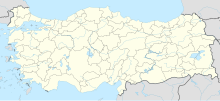Ayanıs
Coordinates: 38 ° 42 ′ 29.8 " N , 43 ° 12 ′ 40.2" E
The Urartian fortress of Agartı Kalesı in Ağarti (formerly Ayanis) is 35 km north of Van on a rocky promontory 250 m above Lake Van (1867 m above sea level). The fortress controls the road from Turušpa to Erciş . It was founded in the 7th century under Rusa II and was named Rusaḫinili Eidoru kai (English: Rusa's city across from Mount Eiduru ) to distinguish it from the eponymous Rusaḫinili ( Toprakkale ). Ayanıs was one of the great Urartian fortresses (É.GAL), which probably served as the capital alongside Tušpa . Ayanıs was probably destroyed by an earthquake and not rebuilt afterwards.
Excavations
Excavations took place in 1989–1997 under the direction of Altan Çilingiroğlu from the Ege Üniversitesi . Among other things, a tower temple ( susi ) was discovered for the imperial god Ḫaldi . An inscription from this temple also mentions sacrifices of sheep for the moon god Šelardi . The excavations focused on the interior of the fortress. So far, around 10% of the area has been exposed. The inscription at the entrance of the pillared temple is one of the longest known from Urartu. It is dug into a basalt block.
“Rusa says: This rock was untouched, nothing had been here before. I have built a sanctuary and a fortress to perfection, I have planted new wings and orchards and founded a settlement. " The inscription ends with the usual curses against the one who erases the name of Rusa and inserts his own name: " May Ḫaldi and the weather god and the sun god annihilate him. "
architecture
The mud brick walls stood on stone foundations, the foundations were carved into the natural rock. In the south, the foundations are made of basalt, the preferred material of Urartian architects, otherwise the existing limestone. The entrance is in the southeast and is secured by two towers. An inscription on the gate names Rusa, son of Argišti, as the builder of the fortress "in front of Mount Eidoru ", who received divine honors and to whom animals were sacrificed.
Finds
Some of the rooms contained finds in situ , which is an indication of sudden abandonment or disaster. Some of the ceramics have pottery marks, a total of 141 different characters, stamped or incised. In the Ḫaldi temple, the offerings that had originally hung on the walls lay on the floor where they had fallen when the fortress was destroyed. Nor had they been looted afterwards, an indication of the extent of the disaster.
literature
- A. Çilingiroğlu: Ayanıs. An Iron Age Site in the East. In: SR Steadman, G. McMahon: The Oxford Handbook of Ancient Anatolia 10'000-323 BCE Oxford 2011.
- A. Çilingiroğlu: Ayanıs Fortress. In: K. Köroğlu, E. Konyar (eds.): Urartu. Transformation in the East. Istanbul 2011, pp. 338–363.
- A. Çilingiroğlu: Recent Excavations at the Urartian Fortress of Ayanıs. In: AT Smith, KS Rubinson (Eds.): Archeology in the Borderlands. Investigations in Caucasia and Beyond. Los Angeles 2003, pp. 197-212.
- A. Çilingiroğlu, M. Salvini: Ayanıs I. Ten Years' Excavations at Rusaḫinili Eiduru-kai 1989–1998. Rome 2001.
- A. Çilingiroğlu, M. Salvini: Rusaḫinili in Front of Mount Eiduru. The Urartian Fortress of Ayanıs (7th Century BC). In: Studi micenei ed egeo-anatolici (SMEA). 35, 1995, pp. 111-124.
- A. Çilingiroğlu: Decorated stone vessels from the Urartian fortress of Ayanıs. In: Tel Aviv. 21, 1994, pp. 68-76.
- A. Çilingiroǧlu, M. Salvini: When Was the Castle of Ayanıs Built and What Is the Meaning of the Word 'Šuri'? In: A. Çilingiroǧlu (Ed.): Proceedings of the Fourth Anatolian Iron Ages Colloquium held at Mersin, 19-23 May 1997. London 1999, pp. 55-60.
- Z. Derin: Potters' Marks of Ayanıs Citadel, Van. In: A. Çilingiroǧlu (Ed.): Proceedings of the Fourth Anatolian Iron Ages colloquium, Mersin, 19-23 May 1997. London 1999, pp. 81-100.
- A. Ü. Erdem, A. Batmaz: Contributions of the Ayanis Fortress to Iron Age Chronology. In: Ancient Near Eastern Studies (ANES). 45, 2008, pp. 65-84.
- U. Hellwag: LÚA.ZUM-li versus LÚA.NIN-li. Some Thought on the Owner of the so-called Prinzensiegel at Rusa II's Court. In: A. Çilingiroǧlu, G. Darbyshire (Ed.): Proceedings of the Fifth Anatolian Iron Ages Colloquium held at Van, 6-10 August 2001. London 2005 .
- MW Newton, PI Kuniholm: A Revised Dendrochronological Date for the Fortress of Rusa II at Ayanıs: Rusaḫinili Eiduru-kai. In: A. Çilingiroǧlu, A. Sagona (eds.): The Proceedings of the Sixth Anatolian Iron Ages Colloquium held at Eskişehir, August 16-20, 2004. Leuven 2007, pp. 195-206.
Individual evidence
- ↑ Zafer Derin: Potters' Marks of Ayanıs Citadel, Van. In: Anatolian Studies . 49, 1999, p. 85.
- ↑ Altan Çilingiroǧlu: Recent excavations a the Uratian Fortress of Ayanis. In: Adam T. Smith, Karen S. Rubinson (Eds.): Archeology in the Borderlands. P. 201.
- ↑ Altan Çilingiroǧlu: Recent excavations a the Uratian Fortress of Ayanis. In: Adam T. Smith, Karen S. Rubinson (Eds.): Archeology in the Borderlands. P. 205.
- ↑ Altan Çilingiroǧlu: Recent excavations a the Uratian Fortress of Ayanis. In: Adam T. Smith, Karen S. Rubinson (Eds.): Archeology in the Borderlands. P. 177.
- ↑ Altan Çilingiroǧlu: Recent excavations a the Uratian Fortress of Ayanis. In: Adam T. Smith, Karen S. Rubinson (Eds.): Archeology in the Borderlands. P. 208.
- ↑ Zafer Derin: Potters' Marks of Ayanıs Citadel. Van. In: Anatolian Studies. 49, 1999, p. 81.
- ↑ Tuğba Tanyeri-Erdemir: Agency, innovation, change, continuity: considering the agency of Rusa II in the production of the imperial art and architecture of Urartu in the 7th Century BC. In: DL Peterson, LM Popova, AT Smith (Eds.): Beyond the Steppe and the sown. Proceedings of the 2002 University of Chicago Conference on Eurasian Archeology. (= Colloquia Pontica. 13). Brill, Leiden 2006, ISBN 90-474-0821-7 , p. 265.
